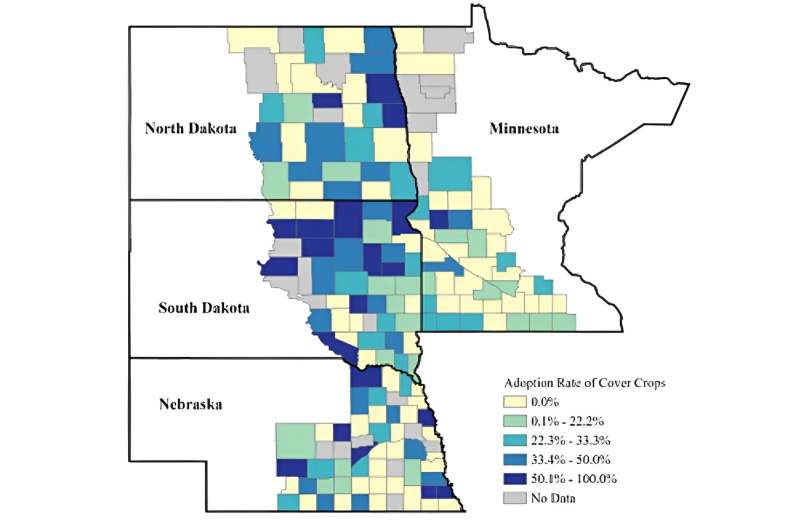This article has been reviewed according to Science X's editorial process and policies. Editors have highlighted the following attributes while ensuring the content's credibility:
fact-checked
trusted source
proofread
Researchers explore farmers' response to high fertilizer prices

In 2022, fertilizer prices reached record high levels due to the Russia-Ukraine war and supply chain disruptions from the COVID-19 pandemic. This has created a financial strain on farmers as nitrogen, phosphorus and potassium—elements found in most synthetic fertilizers—are essential for crop growth and make up a significant portion of a farm's operating cost.
The high prices have incentivized farmers to adjust their practices. In a new study titled "Impact of High Fertilizer Prices and Farmers' Adaptation Strategies in the U.S. Midwest" published in Choices, South Dakota State University researchers explored what strategies are being deployed by farmers in South Dakota, Minnesota, Nebraska and North Dakota to combat these costs.
"To assess farmers' adaptation strategies to high fertilizer prices and the effectiveness of different strategies in reducing the use of synthetic fertilizer, we conducted a survey," said Tong Wang, associate professor in SDSU's Ness School of Management and Economics and the primary investigator in the study. "The results of our work fill in the gaps on producers' short- and medium-term responses to increased synthetic fertilizer prices."
The research team—which included Wang; Matthew Elliott, associate professor in the Ness School; Heidi Sieverding, research scientist at the South Dakota School of Mines; and Stephen Cheye, graduate research assistant with the Ness School—found that 78% of producers had taken on some form of adaption strategy due to the costs. The most common adaption was the use of variable-rate fertilizer application, a tool that aims to enhance fertilizer use efficiency, followed by manure/compost. A smaller percentage of farmers chose to adopt cover crops, and some decided to change their crop rotation.
"We also asked producers to rate their likelihood of using these practices in the next three years if the current prices or supply shortage continue," Wang said. "Farmers are more likely to make medium- and long-term adaption plans than short-term adaption decisions if high fertilizer prices continue."
The use of biofertilizers—also known as microbes—was a new type of technology and had the lowest adoption rate of all the listed strategies. However, a comparison between farmers' short- and medium-term responses shows biofertilizers will likely have the highest growth rate of all the strategies.
"Our findings revealed that farmers are highly interested in investing in new technologies, such as biofertilizers and variable-rate fertilizer," Wang said. "This calls for more research and development efforts to advance the use of biofertilizers and address its performance inconsistency challenges."
In comparison to the interest surrounding biofertilizers, there was less interest—depending on where the farmer was located—in utilizing cover crops and diversified crop rotations to combat the high costs of synthetic fertilizers. The research team notes this could be due to the relatively long period for their benefits, such as reduced requirement for fertilizer inputs, to manifest. Farmers' adaptation strategies also depend on regional weather patterns and other related factors. For example, farmers in South Dakota were more likely to utilize cover crops than the other three states.
"The nonuniform increase in cover crop adoption rates could be attributed to recent flooding events, which likely introduced farmers in the severely affected regions to using cover crops," Wang explained. "Similarly, the fertilizer price spike will likely shift farmers toward alternative resources."
Overall, fertilizer was ranked as the issue having the greatest influence on farming operations during the survey implementation period (summer 2022), followed (distantly) by extreme weather and fuel prices.
"Policy assistance during extreme events such as natural disasters or fertilizer price spikes, if designed properly, could incentivize producers to adopt individual conservation practices or combinations that are ideal for their region," Wang said. "In the long term, social benefits will accrue as more farmers become accustomed to using conservation practices as adaption strategies to such events or as a norm in their agricultural production."
More information: Impact of High Fertilizer Prices and Farmers' Adaptation Strategies in the U.S. Midwest. www.choicesmagazine.org/choice … es-in-the-us-midwest
Provided by South Dakota State University





















